Introduction
The development of toothpaste first started with the aim to remove debris from teeth but since then the demand from toothpaste has taken different transitions from prevention of dental caries to whitening of tooth, breath freshening and recently to prevention of bacterial infection (such as gingivitis and tooth decay), dental erosion, dentine hypersensitivity, oral cancer and gum bleeding, as well as to remove tartar/calculus and yellowness of tooth. This however is done by continuously changing the composition of the toothpaste.
IMAGE1: TOOTH DEBRIS
Toothpaste has been classified into two basic types: the non-herbal and herbal toothpastes. Toothpastes can also exist in two forms: tooth powder and paste (i.e gel) which can be stored in can, jar and collapsible tube. Despite the benefits of most nonherbal toothpaste in aspect of dental anticaries, tooth whitening and antigingivitis/antitartar capacities, there is still looming challenges of chemical toxicities of the ingredients of this toothpaste that are claimed to be dangerous to oral health and aquatic life.

IMAGE2: GEL OR NONHERBAL TOOTHPASTE.
Furthermore, in the need to overcome the scorch of unemployment among the youth in the world, the science of toothpaste making can be practised for cottage industry but should be allowed to go through federal drug agency before being sold to the public. Here in this article, I addressed how to make toothpaste, toothpaste ingredients and their respective functions, manufacturers’ terminologies, challenges to be encountered in nonherbal toothpaste production and solutions, as well as anecdotal dangers associated with this said toothpaste and future perspectives. I hope any reader will find it useful and interesting!!!
History
The first dental cream was targeted at eliminating debris from teeth which constituted with powdered ashes from myrrh, oxen hooves, pumice and egg shell dissolved in water, and was developed by ancient Egyptians (between 3,000–5,000 BC). Also ancient Iran (around 1,000 BC) added to this concoction: herbs, honey, gypsum and burnt oyster and snail shells. Although the abrasive composition of the toothpaste increased with oyster shells and crushed bones by earliest Romans and Greeks, but the Romans further later added flavours to the toothpaste through less powdered charcoal and bark around 1000 years later in order to removing the bad breath with then toothpaste. The earliest Chinese used instead the herbal mints, salts and ginseng that looked like nowadays’ toothpastes. In the 18th century, powder toothpaste was emerged on the aim to clean the tooth and developed by medical and natural scientists. The former creamy toothpastes were too expensive and had high level of abrasiveness and poor taste; likewise the latter tooth powders were too harsh and abrasive to tooth owing to their composition such as crushed china, brick dust, cuttlefish and earthenware.
However at the ends of 18th and 19th centuries, borax powder (sodium borate) and Glycerine were added to tooth powders to give the foaming effect and to turn it into a paste, make it more palatable and prevent the paste from evaporation respectively. Between these two periods, strontium and salts or soap of fatty acids such as sodium palmitate were constituted in toothpaste for strengthening and reduction of sensitivity of teeth, and for foaming respectively. Toothpaste was first sold in a jar and later in a collapsible tube by Colgate & Co (In 1873) and by Washington Sheffield (in 1892) respectively.
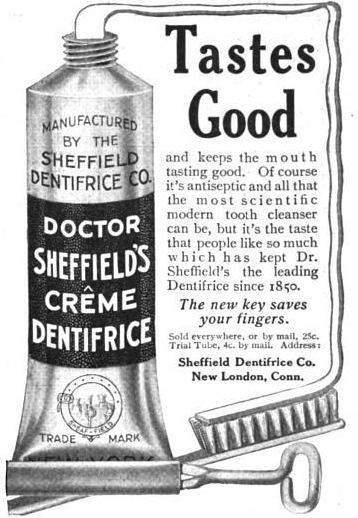
IMAGE3: INVENTION OF COLLAPSIBLE TOOTHPASTE BY Dr Washington Sheffield.
The use of fluorides (such as sodium or stannous fluoride) as dentifrice and anticaries in children by the British (between 1914 to1915) and its fortification with calcium phosphate as abrasive and mass marketing by USA (in 1956) revolutionised toothpaste technology towards oral health and led to emergence of fluoride toothpaste (that actually legalised in 1960) around the world. Sodium lauryl sulphate (SLS) was later emerged after World War II as a synthetic surfactant which is still in use today.
What are the types of toothpaste?
Toothpastes are classified into different types depending on the state of the material composition and sources of the material composition.
Base on the nature of the material, toothpastes can be (i) gel- or paste-typed and (ii) powder-type.
Based on the sources of the material, toothpastes can be (i) artificially or chemically produced or non-herbal toothpaste, (ii) pure herbal or natural toothpaste and (iii) chemical-herbal mixture toothpaste.
Other classifications of toothpaste depend on the objectives of the manufacturers which are consumer-driven and sometimes generally termed designer toothpastes. These include fluoridated, non-fluoridated, abrasive, clear coloured, colour-striped and white toothpastes etc. Also, many types of toothpaste have different trade names but their respective compositions determine whether they are herbal or nonherbal or both, hence emphasising the pertinence of toothpaste composition.
What is the gel or non-herbal toothpaste?
Nonherbal toothpaste is made from synthetic chemicals and is classified into pure coloured gel or striped coloured toothpastes. The pure coloured can be pure white, red, blue etc., whereas striped coloured can have two or more colours in form a stripe coming out from the collapsible tube, all for the purpose of cosmetics and appeal to the sight to the consumers. Some gel toothpaste takes cognisance of the following characteristics of toothpaste such as abrasiveness, fluoride-fortified etc, and through this their compositions are continuously changing to suit the consumers’ choices.

IMAGE4: STRIPED COLOURED TOOTHPASTE
What are the consumers-driven aims of the toothpaste manufacturers with their associated terminologies?
Different consumers have different choices for toothpaste they used. For example, toothpaste required of cigarette-smokers will have more abrasive and dentifrice material than general toothpaste. Therefore, toothpaste production is consumers’ choice-driven.
Other properties that toothpaste possesses that stimulate increase in sales depending on the choice of consumers include:
Soft abrasiveness, better breath freshening, tooth whitening, improved stain removal, less expensiveness, ability to prevent and fight against varieties of oral diseases, capacity to improved oral health and cosmetic benefits.
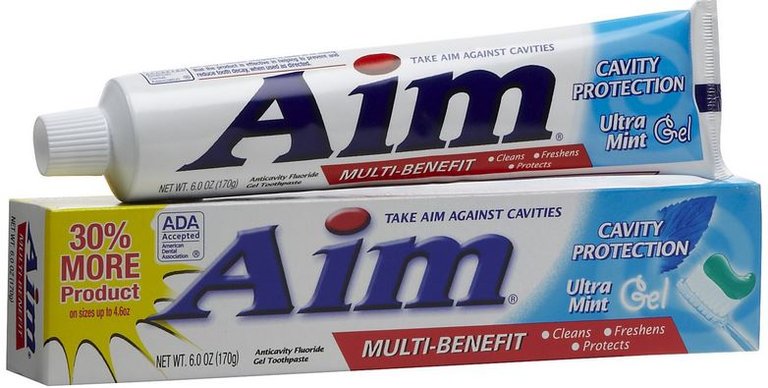
IMAGE5: GEL TOOTHPASTE TARGETED FOR CAVITY PROTECTION
However, the following terminologies are used in toothpaste technology and are of importance to the manufacturers in explaining the preparation of toothpaste, and compatibility and functions of the ingredients of the toothpaste, of some ingredients of toothpaste.
The major ingredient types include: the humectants or liquid base, abrasives or filler, rheology and viscosity modifier, surfactants or detergents, fluoridation or active ingredients, flavouring, sweeteners, colouring and preservatives, whereas some excipient ingredients such as antigingivitis and antiplaque agents, anti-malodour agents, antitartar/anticalculus agents, whitening agents, dentine desensitizers, erosion prevention agents, water, mica, herb, ethanol, vitamins, enzymes, allantoin, and polyethylene/polypropylene glycol which are added on the consumer requests and discretion of the manufacturers.
(i) Active Ingredients: is the treatment of toothpaste with fluorides (such as sodium or strontium fluorides or sodium monofluorophophate) due to its anticaries and cariostatic property in children and dentifrice (tooth-cleaning) property. The safety dose for fluorides is between (250–1,500 ppm) in EU and (250-1150) in USA. Abrasives are problems of fluoridation because they will reduce the con¬centration of soluble fluoride (such as sodium or strontium fluorides) in formulation over time but the best fluoride is sodium monofluorophophate because of its (monofluorophophate) ion is compatible to many abrasives such as Ca, Mg or Al pyrophosphates.
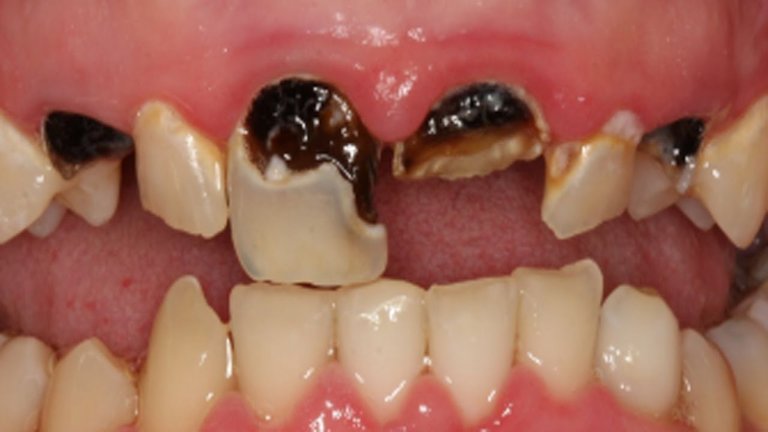
IMAGE6: FLUORIDATED TOOTHPASTE IS TARGETED AT DENTAL CARIES
(ii) Abrasives: abrasives are harder ingredients in toothpaste that remove stains from the tooth without causing significant damage to the tooth surface. Factors that affect abrasiveness of toothpaste include particle hardness, shape, size, size distribution, concentration, applied load, toothbrush filament diameter, and shape during brushing. The abrasives used in toothpastes include hydrated silica and calcium carbonate (both are most commonly used and used together at 8 and 20% w/w), dicalcium phosphate dehydrate and calcium pyrophosphate (both are used together), alumina and perlite (both are with high abrasiveness and used at approx. 1–2% w/w), sodium bicarbonate (the lease abrasive and used in excess of 50% w/w), nano-hydroxyapatite and sodium metaphosphate. Recall, calcium
carbon¬ate should not be formulated with sodium fluoride because it reduces fluoride bioavailability.
(iii) Surfactants or Detergent: surfactants in toothpaste help in foaming action, intraoral dispersion and micellization of hydrophobic ingredients of the toothpaste. Surfactants can be anionic, cationic, nonanionic and amphoteric. The anionic and cationic are more irritant than amphoteric while non-ionic is the least irritant. Surfactants include sodium dodecyl sulphate or SLS, sodium lauroyl sarcosinate and sodium cocoyl sarcosinate are anionic surfactants, while amphoteric surfactant include cocamidopropyl betaine, and nonanionic surfactants such as polyethylene glycol (i.e Steareth-30) and alkyl sulfonates (i.e sodium C14–16 olefin sulfonate and sodium C14–17 secondary alkyl sulfonate). The anionic is the most forming surfactant, followed by the amphoteric but the non-anionic is the least of the foamers. Surfactants are mostly utilized at con¬centrations of 0.5 to 2.5% w/w.
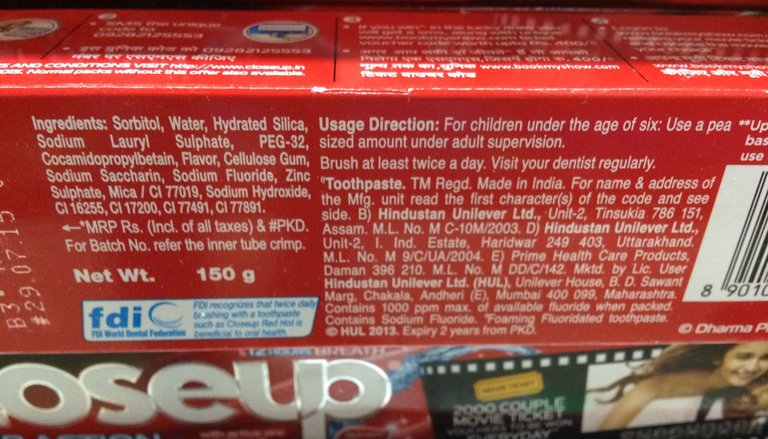
IMAGE7: GEL TOOTHPASTE COMPOSITION
(iv) Viscosity and Rheology Modifiers: viscosity is characterised with the thickness and stickiness of the toothpaste whereas rheology is the flow of the toothpaste from the tube. Therefore, viscosity and rheology modifiers help to produce a gel phase with a homogeneous distribution of all ingredients in toothpaste and to prevent these components from separating during duration of storage, as well as to produce an easy flow of toothpaste from the tube with a clear break without stringy appearance and a good ribbon stand-up when spread to a toothbrush. The most common viscosity and rheology modifiers are carboxymethyl cellulose, hydroxyethyl cellulose, carrageenan, xanthan gum, cellulose gum, and crosslinked polyacrylates which are utilized at concentrations of 0.5 to 2.0% w/w and thickening silica at approx. 10% w/w.
(v) Humectants or liquid base: the capacity of toothpaste to avoid being water-separated, drying out and losing texture and flavour at the point of dispensing is caused by the presence of humectants in it. The humectant also gives toothpaste its glossy and smooth appearance, and homogenous delivery pattern. The commonly used humectants are glycerine and sorbitol, typically between 20 and 30% w/w with sorbitol at higher concentration. Glycerine cannot be used together with rheology and viscosity modifiers because the toothpaste suffers the risk of ingredient separation during long-term storage. Also, increase in sorbitol than glycerine suffers from drying out or ‘capping-off’ and stringy appearance. Therefore, most manufacturers prefer the formulations containing water, sorbitol and glycerine.
(vi) Flavouring: the idea of adding flavours to toothpaste is to provide breath freshening, certain sensational (i.e cooling, tingling or heating) and conceal the unpleasant taste of surfactants. Most commonly use is the mint flavour, and others are from herbs, lemons and cinnamon at concentration between 0.3 and 2.0% w/w. However, flavours are the most volatile and expensive ingredients in toothpaste.
(vii) Sweeteners: these are added to toothpaste to make it tasty and kill the bitterness of surfactants and other ingredients. Artificial sugar such as saccharin are mostly used but the rarely used is sucralose at concentration 0.2-0.5% w/w and Xylitol at concentration of approx. 10% w/w).
(viii) Colouring: is utilised for consumer acceptability. Therefore, toothpaste can be pure colour (i.e pure white, blue or reddish etc) and striped colour. Artificial colorants (approx. 0.1% w/w) are added to get coloured stripes, while white colour is achieved by adding titanium dioxide (approx. 0.1-1% w/w). Stripes can be introduced by (i) filling one or more striped core into different compartments of the tube or (ii) filling a single compartment tube simultaneously with striped cores of the same paste. The white toothpastes (of refractive index of approx. 1.45) can be realised by a certain humectant/water ratio and choice of abrasive (like silica).
(ix) Preservatives: the aim is to prevent microbial growth during long storage. Toothpaste with anionic surfactant may not need preservatives because anionic surfactants are inherently antimicrobial, while those without anionic surfactants required preservatives such as sodium benzoate and ethyl and methyl paraben at approx. 0.2% w/w. Likewise, high humectant levels can also prevent microbial growth owing to the high osmotic pressure in the aqueous phase.
(x) Antigingivitis/Antiplaque Agents: plaque is a film of bacteria that have built up and deposited on teeth surface and which majorly caused tooth decay and gum disease. Plaque can harden into tartar or calculus which is the organic material that is hardened and formed on the gum line and capable of causing tooth decay if not regularly scrapped off. Gingivitis on the other hand is the inflammation of the gum which can be caused by plaque. The most commonly utilised and scientifically proven antiplaque/antigingivitis agents in toothpastes include stannous chloride/fluoride, triclosan, and zinc citrate/chloride. The triclosan (0.3% w/w) is used together with Gantrez (2% w/w) because the latter claimed to augment the intraoral substantivity of the former.
(xi) Anti-malodour Agents: volatile sulphur compounds (VSCs) such as methyl mercaptan and hydrogen sulphide are products of bacterial fermentation that caused mouth odour and are the targets of the anti-malodour agents such as Zinc chlorides and citrates, that convert them into non-volatile zinc sulphides.
(xii) Antitartar/Anticalculus Agents: calculus is the solidification of mineral salts around organic material found especially in hollow organs or ducts, while tartar is crust-like material that composed of plaque that has become more solidified by mineral salt deposition. Most commonly utilised antitartar/anticalculus agents in toothpastes are condensed inorganic and organic phosphates such as sodium or potassium salts of the pyrophosphate, tripolyphosphate or hexametaphosphate ion (at 5–12% w/w). Although zinc chlorides and citrates but not in the presence of condensed phosphates.
(xiii) Whitening Agents: whitening is the ability of toothpaste to remove and prevent stains. Therefore, whitening agents can be mechanical, optical and chemical depending on their mode of actions. The chemical whitening agents include condensed sodium or potassium salts of the pyrophosphate, tripolyphosphate or hexametaphosphate ion (at 5–12% w/w) as well as hydrogen peroxide (0.1%-1%). Toothpaste with hydrogen peroxide does bleach the enamel, oxidise the stain molecules and change their absorption spectra which become invisible to the naked eyes. Mechanical whitening agents is simply the physical removal of extrinsic stains and optical whitening agent such as blue covarine which is claimed to stick to the tooth surface, thereby changing the optical properties of the teeth and causing whitening. However, hydrogen peroxide is hard to stabilize in toothpaste formulations.
(xiv) Dentine Desensitization: Dentine Hypersensitivity is the abnormal feelings such as irritation, heat, shock and pains associated with toothpaste. Nerve desensitization can be achieved by potassium citrate and nitrate (approx. 5% w/w), and others are strontium salts (acetate, chloride) (approx. 8% w/w), stannous fluoride, calcium sodium phosphosilicate (‘bioglass’) and arginine bicarbonate in mixture with calcium carbonate. These salts add (bitter) tastes to the toothpaste, reduce fluoride bioavailability and may require non-aqueous formulation.
(xv) Erosion Prevention Agents: dental erosion is the peeling off the enamel and dentine surface. These include the additions of sodium fluoride and stannous fluoride or chloride to remineralise the enamel and dentin surface by forming a protective layer on the dental hard tissues.
(xvi) Water: is used to solubilise most inorganic active ingredients such as fluorides. Therefore, purified water should be utilised to prevent metal impurities such as calcium and other trace elements which can lower the bioavailability and stability of active ingredients in the toothpaste.
(xvii) other miscellaneous ingredients: mica (i.e phyllosilicate mineral family) is utilised for its polishing and sparkling impacts, Sodium hydroxide for pH, vitamins E and C for antioxidant properties, herbal extracts for their antimicrobial properties, enzymes (such as lactoperoxidase, lactoferrin, lysozyme and glucose oxidase) for plaque growth prevention, ethanol for solvent, allantoin for gum health and polyethylene and polypropylene glycols are utilised as dispersants, humectants, and to make xanthan gum (i.e bacteria-formed gum)evenly dispersed in toothpastes.
What are lethal dose, safety dose and recommended dose?
Lethal dose is the dose of a synthetic chemical that can be harmful and deleterious to the consumers or individuals. Safety dose is the dose of a synthetic chemical that will less or no side-effects on the persons that consumed them. The recommended dose is a scientifically proven and guided dose of a synthetic chemical which is legally accepted to be used by chemical users that should be safe for consumption and it is control by federal drug agencies (FDA) of different countries.
Therefore, many gel toothpaste ingredients are considered as synthetic chemicals which thoroughly guided by FDA by ensuring the recommended dose of each ingredient is actually used for public safety. This is carried out by various lab testing or screenings such as antibacterial test, Minimum inhibitory concentration (MIC) test, Storage test, Physicochemical test (i.e pH, Fluoride ion, Heavy metals etc), , Sensory test. Importantly as a cottage manufacturer, all these pieces of information are required for your product to be accepted for sales. Please, with no reason you should sell any consumable product without inviting FDA for proper testing.
How can I produce nonherbal toothpaste?
Yes, you can! What you just need is to follow the steps indicated below and also seek for more information from the internet if need be.
Although toothpaste making process depend on the ingredient used and product types but a general process is highlighted as followed:
(i) First prepare your liquid base or humectant such as water, sorbitol and glycerine, and other liquid ingredients,
(ii) Premix your Rheology modifiers with a non-aqueous liquid ingredient like glycerine or the flavouring oil or you may dry blended with other powdered ingredients to aid dispersion before adding to final mixture,
(iii) You can now add your active ingredients such as sweetener and preservative and stir to disperse,
(iv) Ensure your abrasives are make slurry with water before adding to the final mixture,
(v) you can then add your colouring and flavour,
(vi) Your detergent or surfactant is added last under slow speed agitation to reduce foaming.

VIDEO1: SHORT VIDEO FOR TOOTHPASTE MAKING.
What are the problems associated with gel toothpaste production?
(a) problem due to aeration: this can be overcome by doing your mixing under a vacuum.
(b) problem by rheology modifier: to avoid lumps formed by rheology modifier, please ensure you do your premixing with other liquid or powdered ingredients with high shear force mixer (or rotors if available) in order to save cost and time.
(c) problem of some ingredients such as hydrated silica that can fail to incorporate should be premixed and heat a little to increase its dispersion before adding to the final mixture.
(d) problem with abrasivesuch as calcium carbonate should be premixed into slurry before being added to the final mixture.
(e) Avoid the use of conventional agitator when mixing powder ingredient.
Is giving trial in making non-herbal toothpaste as cottage industry a crime?
No, isn’t a crime! But ensure it undergoes a thorough screening and approval by the FDA of your country before being sold to the public.
Is there any way I can pack the toothpaste in the absence of collapsible tube?
Yes, there is! You can use a small jar or small container in the absence of collapsible tube to put your products provided it has a seal.
What are the anecdotal risks associated with non-herbal toothpaste?
Some of the nonherbal toothpaste ingredients have been claiming to pose danger to human oral health if continuously used for long time, and to aquatic life through water pollution. Bleach and peroxides has been claimed to cause irritation in skins and mouth even in small dose and severe chemical burn in large dose. Artificial flavouring and scent has also fought against by being not safe. Also, preservatives such as EDTA (ethylene diamine tetra acetic acid) and formaldehyde utilised in some gel toothpaste are experimental pollutants.
Triclosan used as antibacterial and antitartar in toothpaste has been claimed to cause water pollution when it combines with other chemical to form dioxin which is a dangerous pollutant. SLS (sodium lauryl sulphate) used as a foaming former in toothpaste has been implicated to cause skin and mouth irritations, canker sores or mouth ulcer, dirt to teeth if not thoroughly rinsed, severe burn (at 30%-40%), male and female infertility and breast cancer since it mimic oestrogen hormone in action, skin drying, mouth odour, allergy in some people. Fluorides have been argued to cause fluorosis at 5mg/kg per body weight especially in children less than 24 or 12 months.
What are future perspectives on toothpaste technology?
Many toothpaste manufacturers are drastically improved on the delivery of fluoride but to enhance fluoride bioavailability in fighting against dental caries are still a dilemma. The brands of toothpaste produced nowadays are consumer-driven, so manufacturers now moved from dental caries to other consumers’ needs such as whitening, breath freshening and preventions of bacterial infection (such as gingivitis and tooth decay), dental erosion, dentine hypersensitivity, oral cancer and gum bleeding, as well as to remove tartar/calculus and yellowness of tooth.
The recent up-roaring of side-effects and environmental pollution of nonherbal toothpaste is of great worries. This as a result may drive the consumers’ choice to the use of herbal toothpastes which are in different brands on the supermarket shelves. The claim of herbal toothpaste being anticaries, anti-gingivitis, anti-tartar and anticancer etc, as well as low cost, to mention a few has generated consumer interest and demand. However, the choice of toothpaste is now consumer-based.
REFERENCES
VIDEO
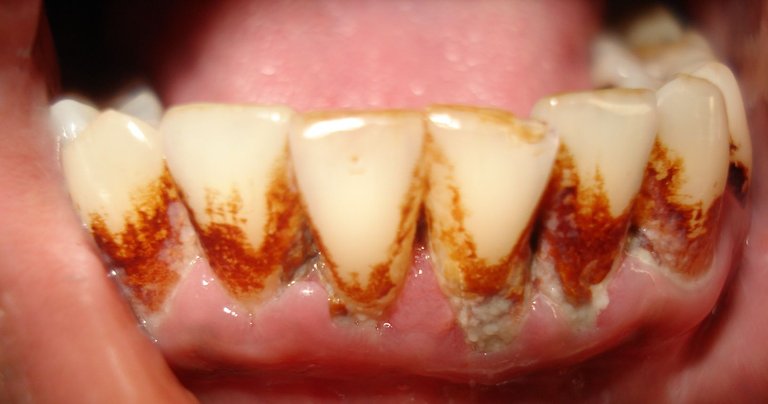
Hey @eyitayoadeyemi, great post! I enjoyed your content. Keep up the good work! It's always nice to see good content here on Steemit! Cheers :)
thank you
Congratulations @eyitayoadeyemi! You received a personal award!
You can view your badges on your Steem Board and compare to others on the Steem Ranking
Do not miss the last post from @steemitboard:
Vote for @Steemitboard as a witness to get one more award and increased upvotes!
Congratulations @eyitayoadeyemi! You received a personal award!
You can view your badges on your Steem Board and compare to others on the Steem Ranking
Do not miss the last post from @steemitboard:
Vote for @Steemitboard as a witness to get one more award and increased upvotes!